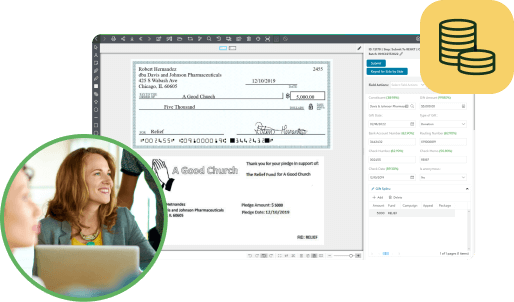Rising inflation is creating new challenges for nonprofits and donors alike. Consumer prices increased by 9.1% over the last year, which is the largest increase seen in 40 years. Because of this sharp decrease in the purchasing power of money, nonprofits are finding it more difficult to cover their expenses—from planning engaging events to providing essential services. At the same time, donors’ giving capacity is lower than usual, making fundraising more difficult.
Many nonprofits, especially humanitarian organizations, are also seeing a demand for their services increase. But with less purchasing power and wiggle room in their budgets, nonprofits are struggling to meet their goals. Although inflation poses a significant obstacle, there are ways that organizations can navigate around this issue and stay afloat.
Nonprofits proved their resilience during COVID-19 and are equally able to stand up to inflation through planning and regular communication with donors and stakeholders. In this article, we’ll provide an overview of how inflation is affecting nonprofits and how your nonprofit can take action. Specifically, we’ll cover:
- Inflation in the Nonprofit Sector
- How Planning Can Combat Inflation
- Fundraising Strategies to Boost Revenue
By taking the time to reflect, prepare and act, nonprofits will be able to confront any challenges that come their way. Let’s begin.
Inflation in the Nonprofit Sector
While inflation is an issue that affects everyone, it may affect some nonprofit organizations more than others (and in different ways).
For example, let’s consider the impact inflation has had on hunger relief organizations. Many of these organizations purchase food, which has increased in price by 10.9% in 2022, and need refrigerated box trucks to transport perishables. However, the cost of refrigerated box trucks has surged by thousands of dollars. As a result, these organizations are finding it more difficult to meet the demand for their services.
Your nonprofit will need to take stock of the specific ways inflation is affecting the following areas:
- Donors. Consider your donors’ demographics and giving capacity. Are they more or less capable of giving their usual donation amounts? Have you been raising more, less or the same amount of revenue over the past year? Are there more or fewer people signed up for recurring giving, and have their donation amounts changed? By reflecting on any changes in your fundraising, you’ll be able to target ways to boost revenue and strengthen donor relationships.
- Programs. With rising costs, you may be experiencing an increased demand for your services. Have more community members attended your programs or events or participated in your services? Consider whether you’ll need access to more in-kind donations, funding or volunteers to meet this demand.
- Budget. Look carefully at your budget and identify the areas where expenses are increasing. Compare your previous year’s budget to your budget this year. How has it changed? Are you meeting your goals, or are you finding that it’s more difficult to cover your usual expenses?
By reflecting on the ways inflation is affecting your nonprofit, you can form a comprehensive plan to improve your nonprofit’s operations. Let’s explore what this plan should look like so you can advance your nonprofit’s mission and overcome challenges.
How Planning Can Combat Inflation
Now that you’ve identified where your nonprofit needs improvement, you can begin forming a plan. This plan should align closely with your nonprofit’s overall goals and provide a clear roadmap for how to move forward.
Follow these steps to create a dynamic plan for the future:
- Work with a fundraising consultant. You can hire a fundraising consultant to carefully examine discrepancies in your budget and pinpoint areas where improvements can be made. Once these areas have been identified, your consultant can guide your nonprofit through a robust planning process that aligns your organization’s goals with strategies to combat inflation.
- Meet with team members and survey stakeholders. Bring together your team members—including your board, organization leaders, staff and volunteers—to discuss insights and opinions. Your team is your most valuable asset, so getting everyone involved can help unify your plan to effectively target all areas of your nonprofit’s operations. You’ll also want to hear from major stakeholders—like influential community members, business owners and recipients of your services—to gather a variety of viewpoints.
- Shape your goals around top priorities. Develop goals with your team members that align with your nonprofit’s mission and will help improve its operations. Delegate responsibilities and create a concrete timeline so all team members have a clear sense of purpose on how they can help.
Once you’ve decided how to restructure your budget, communicate changes and action items to your donors and stakeholders. In these communications, be transparent about your nonprofit’s financial situation and how people can help improve your daily operations. Open and honest communication goes a long way in securing people’s trust and building your organization’s credibility.
Let’s dive into the specific strategies you can use, including conducting outreach to donors, to address rising costs.
Fundraising Strategies to Boost Revenue
When your budget feels limited, it can be hard to provide essential services and help your nonprofit stay on track to achieving its goals. Fortunately, there are several strategies you can implement to boost revenue and combat soaring prices.
Conduct Outreach to Major Donors
You can reach out to your top donors and encourage them to give by calling, emailing, or writing a donation request letter. There are several key elements you’ll want to include in your outreach to convince donors to increase their donation or give more frequently:
- Overview of the problem. Start by describing how inflation has affected your organization. You don’t have to get too technical (avoid using too many statistics), but give a basic overview of your economic situation so donors can understand why you would need more funds.
- Storytelling. In order for your donors to connect with your message and understand the gravity of the situation, you’ll need to incorporate storytelling. For example, you can tell a story about how you weren’t able to supply enough items at your last program. Alternatively, you can spotlight someone that was positively impacted by your organization and how your nonprofit wants to continue providing that same service to others. Appeal to people’s emotions so your supporters are compelled to be a part of the solution.
- Clear call to action. If you’re asking donors to increase their donations, articulate this clearly and suggest how much they should increase it by. For example, you could ask a donor that typically donates $1,000 a month to increase their donation to $1,250 a month. This all depends on your nonprofit’s needs and how much additional funding you’ll need to support your goals.
- Next steps. Provide your donors with your donation page link or—if you mailed your request letter—a donation form to fill out and send back to your nonprofit’s address. If you’re on the phone with your donors, let them know verbally their next steps.
You’ll also want to thank donors for their past contributions and express appreciation for their ongoing support. When donors feel valued, they are more likely to give again, boosting your donor retention and revenue stream for your nonprofit.
Make Giving Easy
It’s always a good idea to make giving easy for donors, whether it’s their first or fifth gift. We want to be sure they can act on their good intentions, as soon as they have them, by providing opportunities (events, appeals, etc.) and tools (online giving pages, self-mailing pledge/gift forms, etc.) that meet their interests and needs. There are many ways to do this, including:
- Converting in-person events to online. These events can be in-person or online, although you may be able to cut costs and save more in the end by hosting a virtual event through live streaming technology. Make sure to market your event widely on relevant platforms, such as email, social media and your website.
- Optimizing your online donation page. Make sure your giving page is mobile-friendly so people can conveniently access it from anywhere and has limited prompts so it will only take a few moments to complete. You’ll also want to brand your donation page to your organization to boost your credibility and build trust with donors. Use a font and color scheme that is consistent with the rest of your marketing materials.
- Establishing a recurring giving program. Recurring giving is a great way to secure a predictable revenue stream that offers donors convenience. Instead of having to fill out your donation page each time to give, donors will sign up for a specific donation amount to be transferred from their bank account to your nonprofit on a certain basis (weekly, monthly, bi-annually, etc.). If you already have a recurring giving program established, ask your donors to increase their donations by $5, $10 or $15 so your nonprofit can better meet its goals.
To support your fundraising efforts, you can invest in fundraising software that simplifies the planning and execution process of events and campaigns. As a result, you’ll be able to save time and money in the long run, allowing your nonprofit to keep its focus on its goals.
Create Corporate Partnerships
A corporate partner can help your nonprofit in a myriad of ways. With the rising popularity of corporate philanthropy, it’s a good idea to start reaching out to corporate sponsors that have similar values. A corporate sponsor can help your nonprofit tackle rising costs and increased demand in the following ways:
- Sponsorships. Corporate sponsors can offer your organization monetary donations to cover events as well as programs and services in turn for advertising.
- Matching gifts. To maximize donations, you can partner with a business that has a matching gifts program. 360MatchPro reported that an estimated $2 – $3 billion is donated through matching gift programs annually — highlighting a great opportunity for your nonprofit to earn more revenue. Plus, donors may be encouraged to give more knowing that their impact will be increased through their employers’ matching gifts.
- In-kind donations. If your organization has a smaller supply due to greater demand, receiving in-kind donations from a corporate sponsor is key. For example, if you’re an animal welfare organization, a corporate sponsor can donate needed items like dog and cat food, bedding and more. This way, you don’t have to spend money on additional items and you can continue supporting your community.
- Access to volunteers. Corporate volunteering is a form of business-led volunteer work that engages employees to support local communities. With increased demand, you may need more volunteers to support your organization’s goals, and corporate volunteers can help fill this gap.
Your nonprofit doesn’t and shouldn’t have to slow its operations because of inflation. Reflect on how inflation has affected your nonprofit and create a plan of action to bring your nonprofit’s operations back to speed. With the right strategies, you can cut costs and continue providing essential work to the community.
Looking to harmonize your fundraising strategy using centralized automation across departments? Get a demo today to see how PairSoft can directly integrate with the largest ERPs to automate the gift & donor process.






